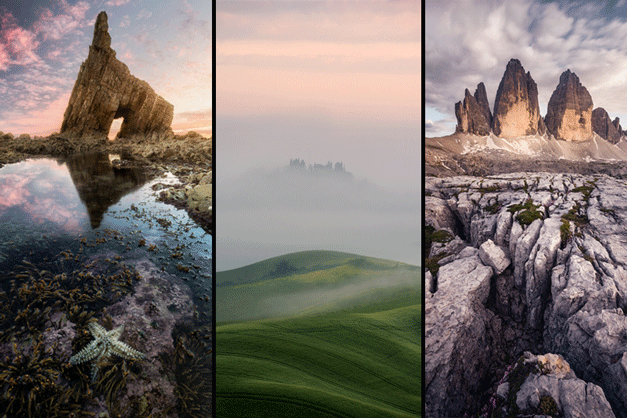4 tips for landscape photography in vertical format

If there is one thing that has distinguished photography since its beginnings in the audiovisual universe, it is the possibility of capturing images in vertical format and viewing the content of its work without any problem, for images in impossible to reproduce on video. Today, we will focus more particularly on landscape photography in vertical format. The vertical format has been gaining more and more followers in video in recent years, with the arrival of smartphones and social networks. Video in vertical format is therefore increasingly popular since it is easier to view images on a device that fits in one hand.
Why using landscape photography in vertical format
But let’s get back to photography and this incredible format in which you can do great work, in landscape photography in vertical format. Composition is essential for an image to be properly interpreted by the viewer and for it to convey what the photographer sees in a scene. And depending on whether the format of the image is horizontal or vertical, we can give different meanings to the latter.
Landscape photography in vertical format will allow you to give different meanings to your work. If it were made in horizontal format, it would probably tell something else.
One of the reasons why landscape photography in vertical format gives different results is that the eye normally tries to complete the representation of an image horizontally and this is even more the case if it it is a landscape. Horizontal photography has always been associated with landscape photography, so much so that this format has often come to be called horizontal photography or landscape photography. Conversely, vertical photography is associated with portrait photography. The portrait in vertical format stylizes the image and the distortion of the image is much less important, so that the model is not distorted.
Landscape photography is often a documentary discipline, which always seeks the most faithful representation of the state and dimensions of the landscape. We can observe that the same landscape photographed with a wide angle lens will give a different representation than if it is photographed horizontally or vertically. The size of the elements photographed and the distortion produced by this type of lens will affect the result.
1. Work with wide angle lens
At present, there are ultra wide angle lenses that produce almost no distortions and therefore facilitate a faithful representation of the landscape to be photographed. Ultra-wide-angle lenses, such as the DZOFilm Vespid Primes, produce horizontal format images with barely perceptible distortion. This will also give images in vertical format much more practical to achieve, with proportions more in line with reality.
Another element to take into account is the way in which we can play on the lines of flight. They are indeed much more accentuated since the eye travels less distance in this format than in the horizontal format. And it is easier to obtain that the viewer’s gaze is focused on the desired point of interest by means of the lines. And this is even more the case if we start from the base of the image to move towards the center, towards the subject or towards the point of interest that we have in the image.
You should know that the rules of composition are the same in vertical photography, they can be established in the same way as in horizontal photography. With digital cameras, you can employ techniques that play with the limitations of your camera. You will be able to achieve truly amazing vertical images, using software such as Photoshop, in particular.
2. Strengthen the foreground for more impact
One of the main techniques, often used to give an almost surreal touch to the image, is to reinforce the foreground. We thus obtain results with an almost three-dimensional foreground, which also involves us in this landscape, so much so that we have the feeling of almost being able to touch the elements.
This technique comes from the famous multi-focus, used in macro photography to obtain a totally sharp subject, however tiny, with focal lengths at the maximum aperture. In macro photography, the depth of field is often too shallow to have a very clear insect or any other object photographed with a macro lens. The overlay of focused images is in fact very often used. Focus overlaying consists of taking several photos with focus on different areas so that you can overlay them later in Photoshop and thus obtain the desired result, namely a completely sharp subject.
3. Apply the Focus Stacking Technique
In landscape photography in vertical format, we have applied this technique called Focus Stacking. To go beyond the limits of your lens and have a completely sharp plane at once, from the minimum focus distance of the lens to infinity, for a feeling of strength and dynamism that allows the viewer to enter in the landscape.
The technique is exactly the same as in macro photography. We will take several photos using a tripod, at the minimum distance allowed by our working lens, then we will take photos while gradually increasing the focusing distance, up to infinity. One can just as well combine the focus of the foregrounds with the focus on the hyperfocal distance so that it is easier to proceed with the superimposition of the images in focus during the post-processing phase. With this technique, we will give more dynamism to the image, from the foreground to infinity. Why not?
4. Rely on precision accessories
Like Focus Stacking, digital photography has opened up new ways of working for us, like taking vertical panoramic shots by editing together multiple shots taken with a tripod.
This type of vertical panoramic shot can be technically improved with the use of accessories such as a precision rail and a spirit level which will allow the pixels of each vertical image to overlap perfectly. There will therefore be no problem obtaining a clearly visible foreground in the panoramic composition. We can thus obtain a vertical panoramic photo with a lot of information.




